ERP Implementation Proposal for Nestle Company
VerifiedAdded on 2023/06/08
|12
|3084
|268
AI Summary
This proposal suggests the implementation of SAP ECC in Nestle Company to address the challenges faced in communication, procurement, marketing, and human resources. The proposal outlines the benefits of adopting the ERP system and the training needs for employees.
Contribute Materials
Your contribution can guide someone’s learning journey. Share your
documents today.
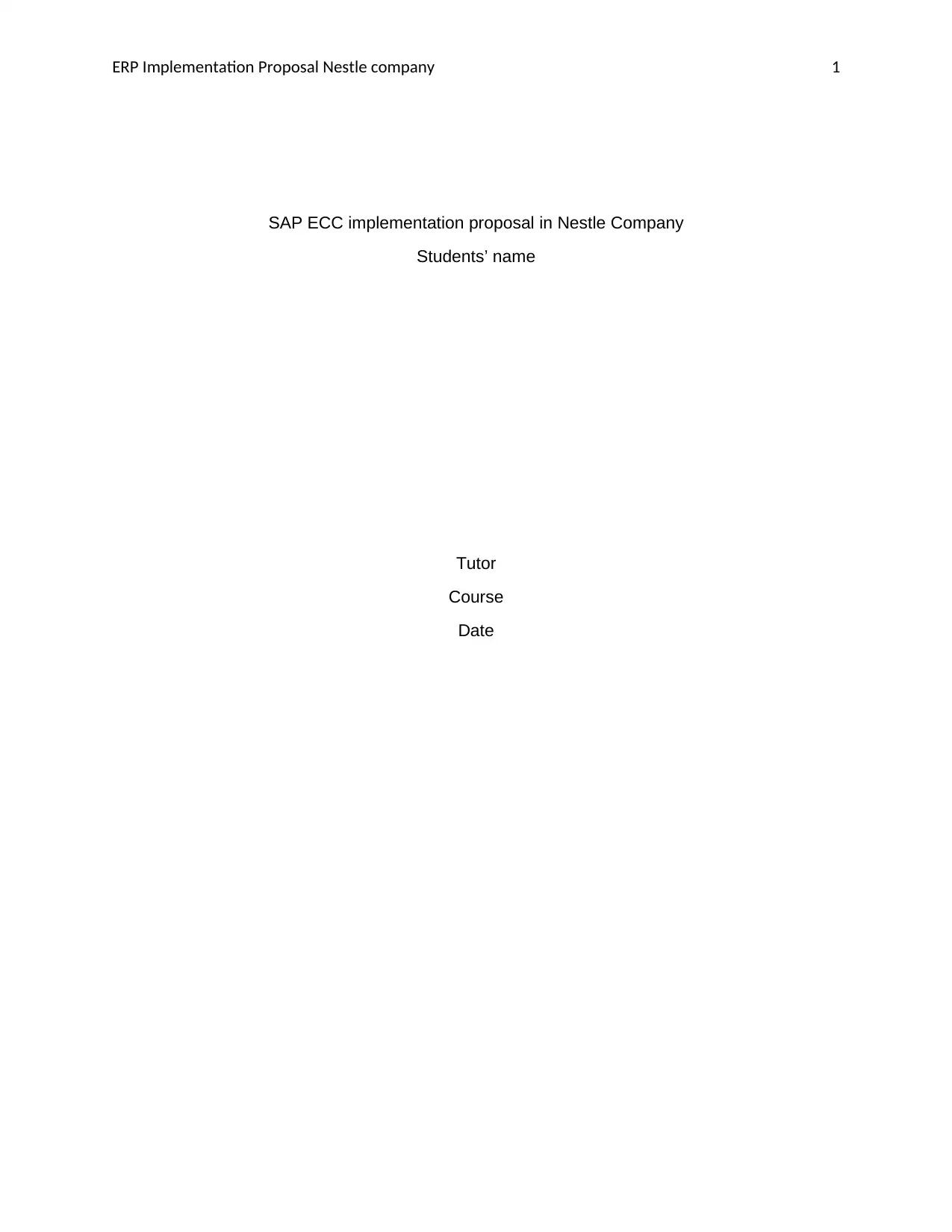
ERP Implementation Proposal Nestle company 1
SAP ECC implementation proposal in Nestle Company
Students’ name
Tutor
Course
Date
SAP ECC implementation proposal in Nestle Company
Students’ name
Tutor
Course
Date
Secure Best Marks with AI Grader
Need help grading? Try our AI Grader for instant feedback on your assignments.
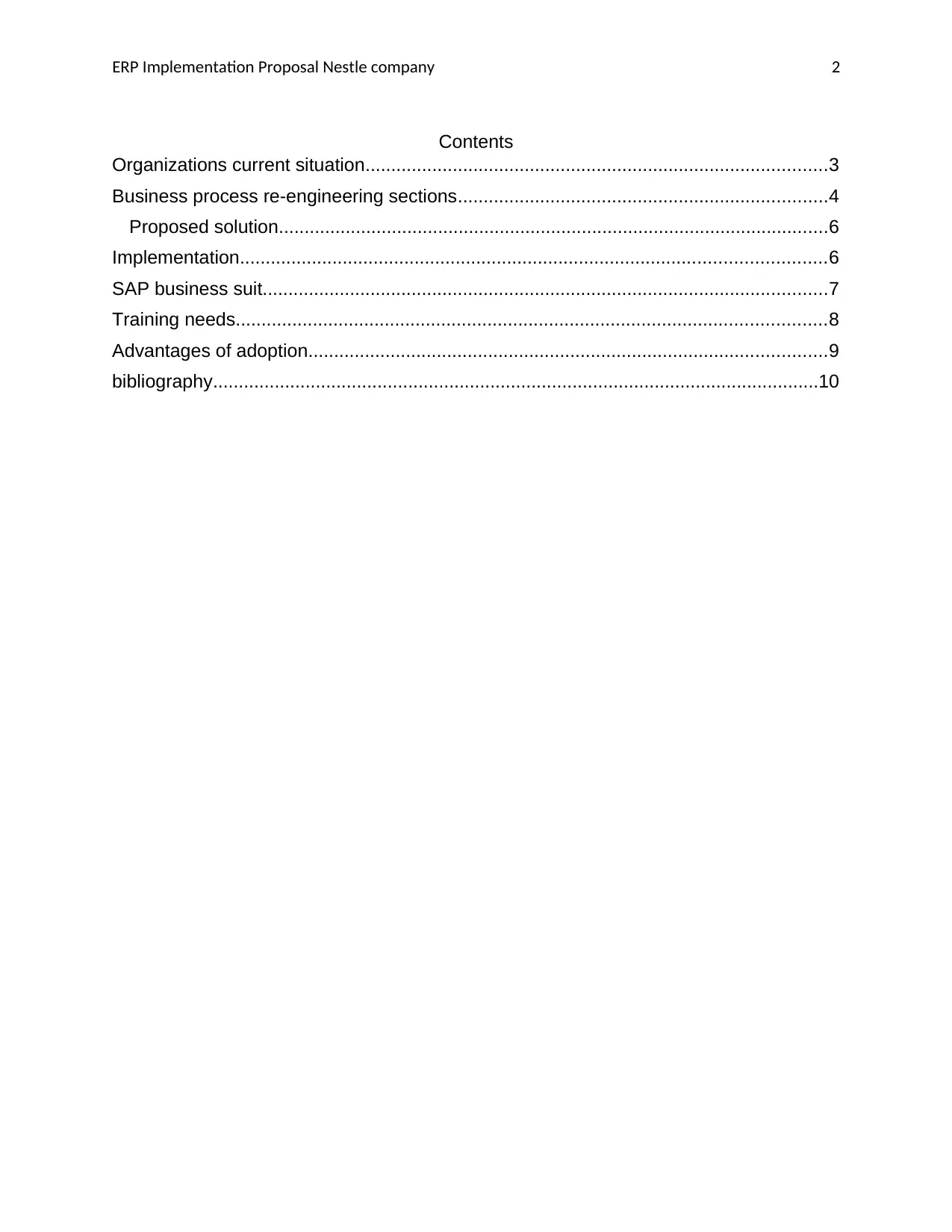
ERP Implementation Proposal Nestle company 2
Contents
Organizations current situation..........................................................................................3
Business process re-engineering sections........................................................................4
Proposed solution...........................................................................................................6
Implementation..................................................................................................................6
SAP business suit..............................................................................................................7
Training needs...................................................................................................................8
Advantages of adoption.....................................................................................................9
bibliography......................................................................................................................10
Contents
Organizations current situation..........................................................................................3
Business process re-engineering sections........................................................................4
Proposed solution...........................................................................................................6
Implementation..................................................................................................................6
SAP business suit..............................................................................................................7
Training needs...................................................................................................................8
Advantages of adoption.....................................................................................................9
bibliography......................................................................................................................10

ERP Implementation Proposal Nestle company 3
Organizations current situation
Nestle company has for long been on the forefront for providing food and pharmaceutical
services in Switzerland. The organization has expanded significantly to cover a large area, and
its services are exceptional based on the quality and amount of revenue generated in the
company (Hudak, 2018). The high revenue development in the company has been attributed to
the positive publicity and the high-quality service provided in the organization. Since the
organization operates all over Switzerland, many branches have been established in all the
major towns and cities in the country. The management of all this entities has however proven
to be a challenge. The current technology employed in the management ensures that each of
the established partners operates independently though they are members of the same
enterprise. There is, however, uniformity in the branding of products, but the operations differ
entirely (Hudak, 2018). For instance, the establishment of vanilla was found out to be offering
completely different services from the main one in Switzerland. The process made it be viewed
as a partnering organization rather than part of the organization itself. The activities differed and
also the pricing of the products was found to be different for two selling points of the same
company.
The ordering system for each unit was also not uniform, and the labeling for the same order
obtained at different selling points was also seen to differ significantly. The various outlets in
America were seen to be independent companies who were affiliated to nestle. The deviation in
services from one outlet to the other reduced the reliability of the operations, and in some other
cases, the operation cost for the organization in one outlet was seen to be higher than that of
the other sections (Monk & Wagner, 2013). There are also challenges being faced in the
efficiency of the organization since the production and distribution process is not coordinated
Organizations current situation
Nestle company has for long been on the forefront for providing food and pharmaceutical
services in Switzerland. The organization has expanded significantly to cover a large area, and
its services are exceptional based on the quality and amount of revenue generated in the
company (Hudak, 2018). The high revenue development in the company has been attributed to
the positive publicity and the high-quality service provided in the organization. Since the
organization operates all over Switzerland, many branches have been established in all the
major towns and cities in the country. The management of all this entities has however proven
to be a challenge. The current technology employed in the management ensures that each of
the established partners operates independently though they are members of the same
enterprise. There is, however, uniformity in the branding of products, but the operations differ
entirely (Hudak, 2018). For instance, the establishment of vanilla was found out to be offering
completely different services from the main one in Switzerland. The process made it be viewed
as a partnering organization rather than part of the organization itself. The activities differed and
also the pricing of the products was found to be different for two selling points of the same
company.
The ordering system for each unit was also not uniform, and the labeling for the same order
obtained at different selling points was also seen to differ significantly. The various outlets in
America were seen to be independent companies who were affiliated to nestle. The deviation in
services from one outlet to the other reduced the reliability of the operations, and in some other
cases, the operation cost for the organization in one outlet was seen to be higher than that of
the other sections (Monk & Wagner, 2013). There are also challenges being faced in the
efficiency of the organization since the production and distribution process is not coordinated
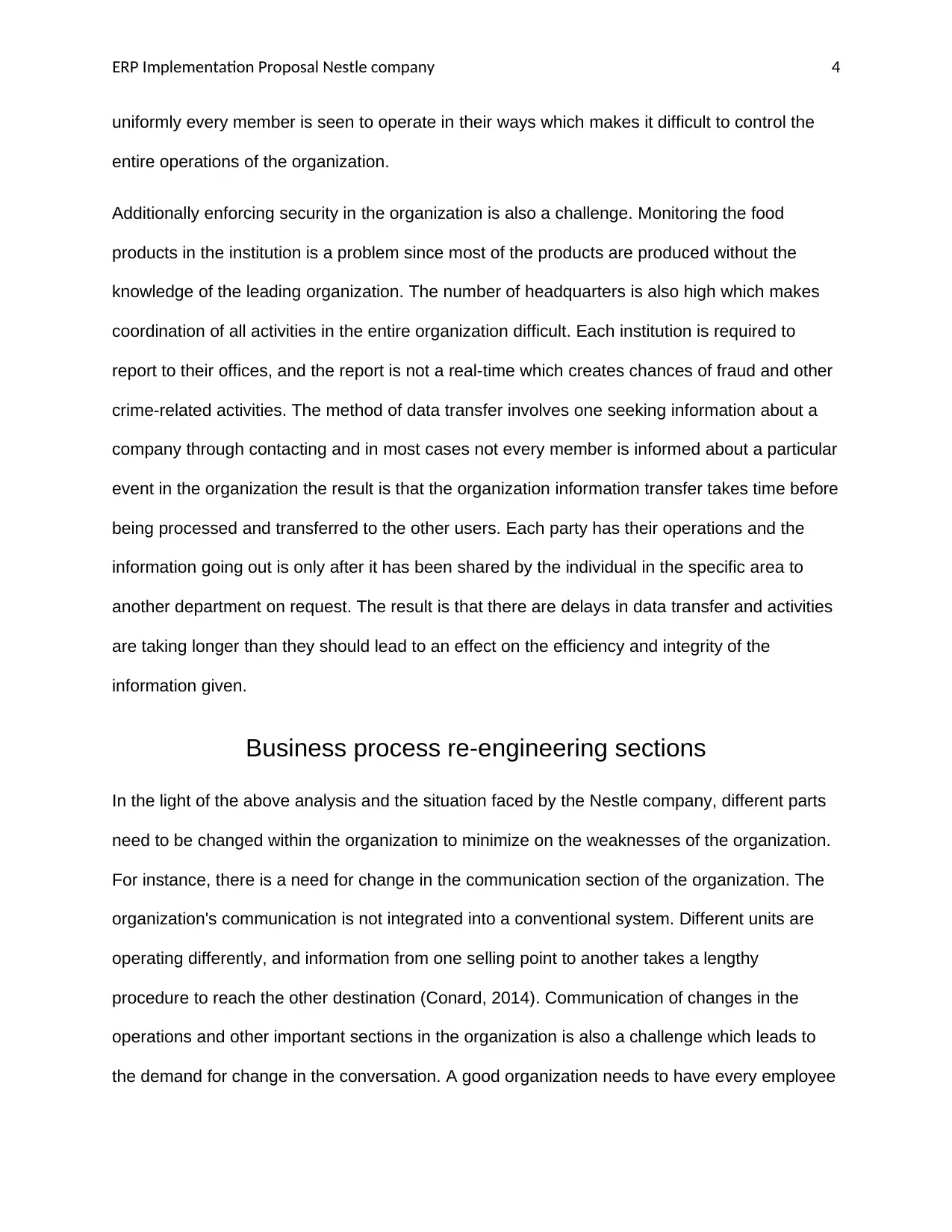
ERP Implementation Proposal Nestle company 4
uniformly every member is seen to operate in their ways which makes it difficult to control the
entire operations of the organization.
Additionally enforcing security in the organization is also a challenge. Monitoring the food
products in the institution is a problem since most of the products are produced without the
knowledge of the leading organization. The number of headquarters is also high which makes
coordination of all activities in the entire organization difficult. Each institution is required to
report to their offices, and the report is not a real-time which creates chances of fraud and other
crime-related activities. The method of data transfer involves one seeking information about a
company through contacting and in most cases not every member is informed about a particular
event in the organization the result is that the organization information transfer takes time before
being processed and transferred to the other users. Each party has their operations and the
information going out is only after it has been shared by the individual in the specific area to
another department on request. The result is that there are delays in data transfer and activities
are taking longer than they should lead to an effect on the efficiency and integrity of the
information given.
Business process re-engineering sections
In the light of the above analysis and the situation faced by the Nestle company, different parts
need to be changed within the organization to minimize on the weaknesses of the organization.
For instance, there is a need for change in the communication section of the organization. The
organization's communication is not integrated into a conventional system. Different units are
operating differently, and information from one selling point to another takes a lengthy
procedure to reach the other destination (Conard, 2014). Communication of changes in the
operations and other important sections in the organization is also a challenge which leads to
the demand for change in the conversation. A good organization needs to have every employee
uniformly every member is seen to operate in their ways which makes it difficult to control the
entire operations of the organization.
Additionally enforcing security in the organization is also a challenge. Monitoring the food
products in the institution is a problem since most of the products are produced without the
knowledge of the leading organization. The number of headquarters is also high which makes
coordination of all activities in the entire organization difficult. Each institution is required to
report to their offices, and the report is not a real-time which creates chances of fraud and other
crime-related activities. The method of data transfer involves one seeking information about a
company through contacting and in most cases not every member is informed about a particular
event in the organization the result is that the organization information transfer takes time before
being processed and transferred to the other users. Each party has their operations and the
information going out is only after it has been shared by the individual in the specific area to
another department on request. The result is that there are delays in data transfer and activities
are taking longer than they should lead to an effect on the efficiency and integrity of the
information given.
Business process re-engineering sections
In the light of the above analysis and the situation faced by the Nestle company, different parts
need to be changed within the organization to minimize on the weaknesses of the organization.
For instance, there is a need for change in the communication section of the organization. The
organization's communication is not integrated into a conventional system. Different units are
operating differently, and information from one selling point to another takes a lengthy
procedure to reach the other destination (Conard, 2014). Communication of changes in the
operations and other important sections in the organization is also a challenge which leads to
the demand for change in the conversation. A good organization needs to have every employee
Secure Best Marks with AI Grader
Need help grading? Try our AI Grader for instant feedback on your assignments.
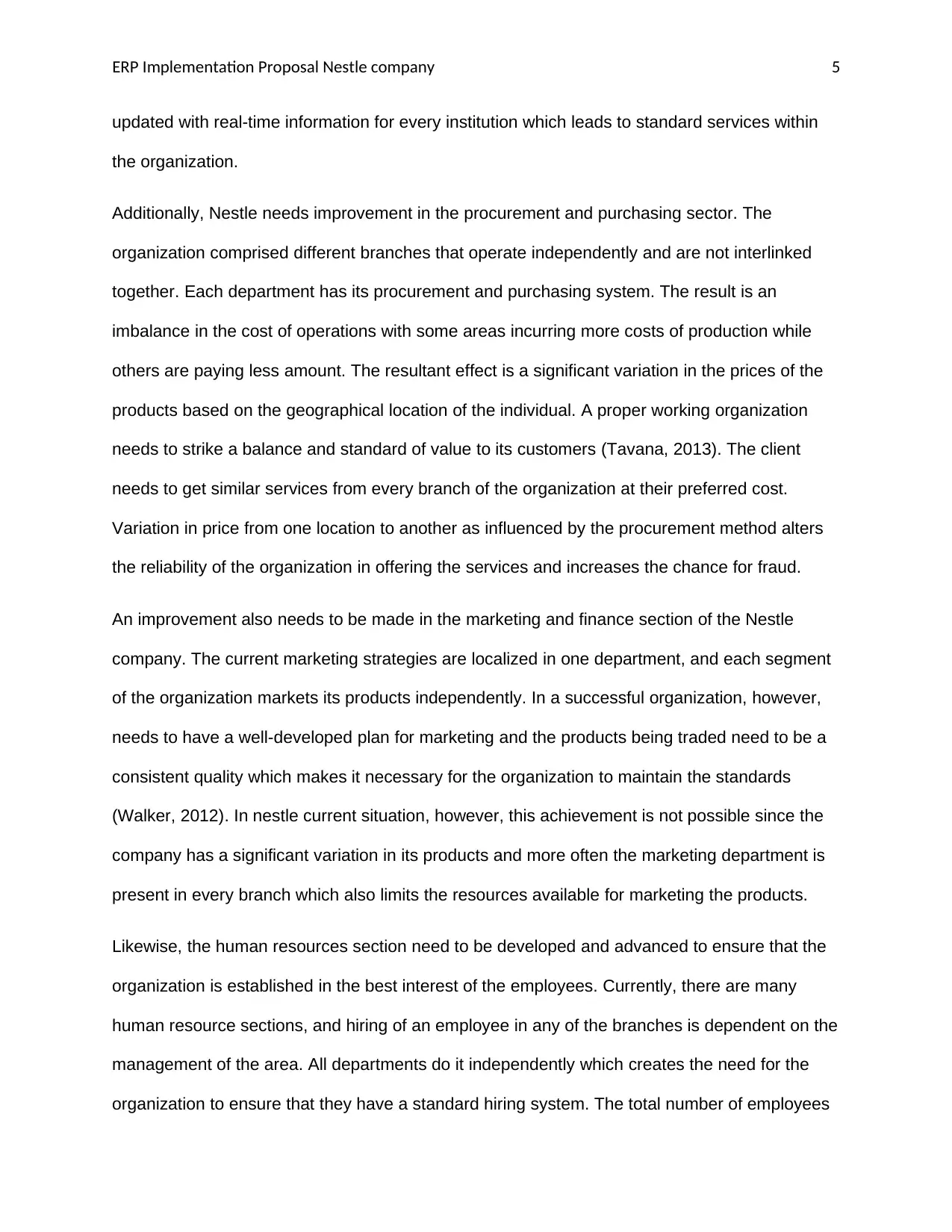
ERP Implementation Proposal Nestle company 5
updated with real-time information for every institution which leads to standard services within
the organization.
Additionally, Nestle needs improvement in the procurement and purchasing sector. The
organization comprised different branches that operate independently and are not interlinked
together. Each department has its procurement and purchasing system. The result is an
imbalance in the cost of operations with some areas incurring more costs of production while
others are paying less amount. The resultant effect is a significant variation in the prices of the
products based on the geographical location of the individual. A proper working organization
needs to strike a balance and standard of value to its customers (Tavana, 2013). The client
needs to get similar services from every branch of the organization at their preferred cost.
Variation in price from one location to another as influenced by the procurement method alters
the reliability of the organization in offering the services and increases the chance for fraud.
An improvement also needs to be made in the marketing and finance section of the Nestle
company. The current marketing strategies are localized in one department, and each segment
of the organization markets its products independently. In a successful organization, however,
needs to have a well-developed plan for marketing and the products being traded need to be a
consistent quality which makes it necessary for the organization to maintain the standards
(Walker, 2012). In nestle current situation, however, this achievement is not possible since the
company has a significant variation in its products and more often the marketing department is
present in every branch which also limits the resources available for marketing the products.
Likewise, the human resources section need to be developed and advanced to ensure that the
organization is established in the best interest of the employees. Currently, there are many
human resource sections, and hiring of an employee in any of the branches is dependent on the
management of the area. All departments do it independently which creates the need for the
organization to ensure that they have a standard hiring system. The total number of employees
updated with real-time information for every institution which leads to standard services within
the organization.
Additionally, Nestle needs improvement in the procurement and purchasing sector. The
organization comprised different branches that operate independently and are not interlinked
together. Each department has its procurement and purchasing system. The result is an
imbalance in the cost of operations with some areas incurring more costs of production while
others are paying less amount. The resultant effect is a significant variation in the prices of the
products based on the geographical location of the individual. A proper working organization
needs to strike a balance and standard of value to its customers (Tavana, 2013). The client
needs to get similar services from every branch of the organization at their preferred cost.
Variation in price from one location to another as influenced by the procurement method alters
the reliability of the organization in offering the services and increases the chance for fraud.
An improvement also needs to be made in the marketing and finance section of the Nestle
company. The current marketing strategies are localized in one department, and each segment
of the organization markets its products independently. In a successful organization, however,
needs to have a well-developed plan for marketing and the products being traded need to be a
consistent quality which makes it necessary for the organization to maintain the standards
(Walker, 2012). In nestle current situation, however, this achievement is not possible since the
company has a significant variation in its products and more often the marketing department is
present in every branch which also limits the resources available for marketing the products.
Likewise, the human resources section need to be developed and advanced to ensure that the
organization is established in the best interest of the employees. Currently, there are many
human resource sections, and hiring of an employee in any of the branches is dependent on the
management of the area. All departments do it independently which creates the need for the
organization to ensure that they have a standard hiring system. The total number of employees
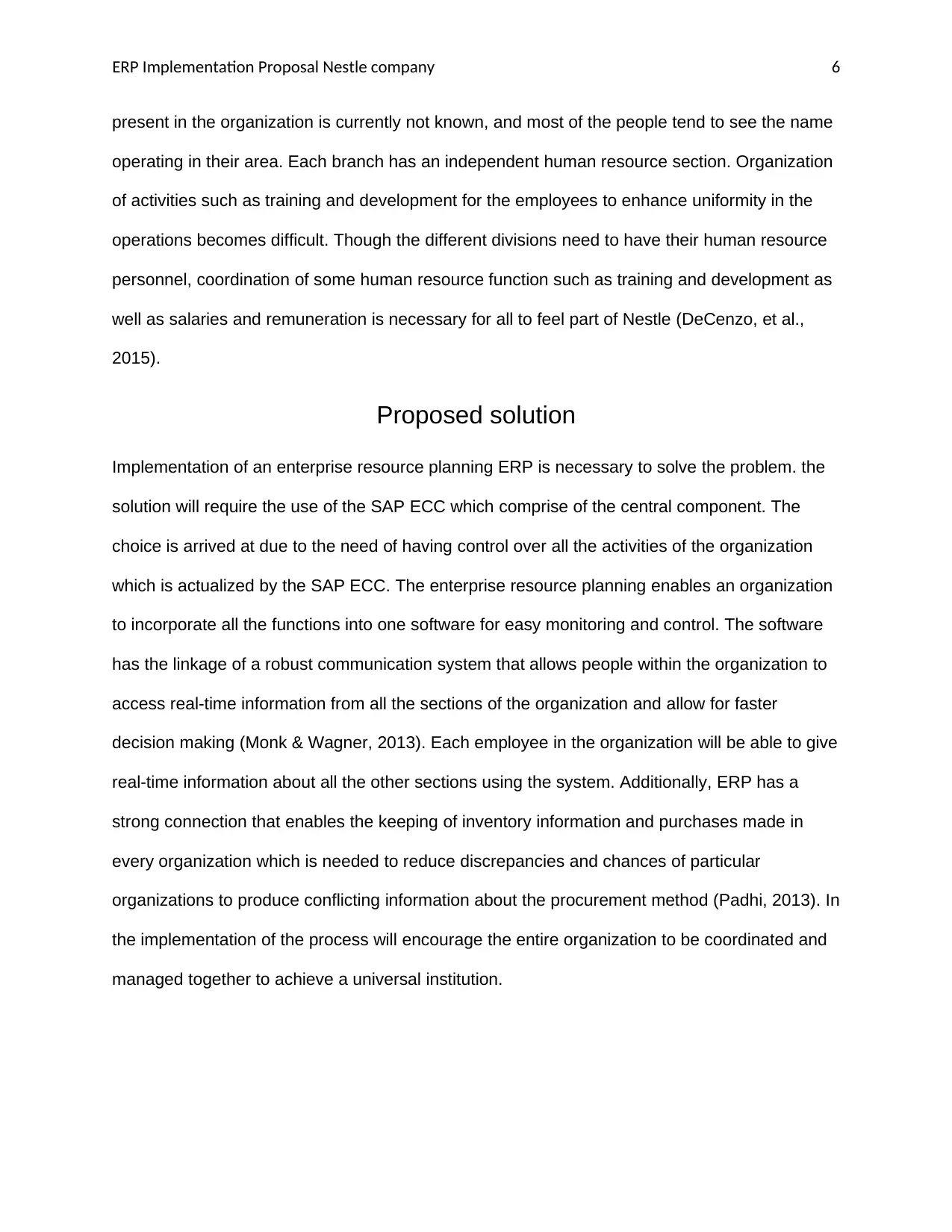
ERP Implementation Proposal Nestle company 6
present in the organization is currently not known, and most of the people tend to see the name
operating in their area. Each branch has an independent human resource section. Organization
of activities such as training and development for the employees to enhance uniformity in the
operations becomes difficult. Though the different divisions need to have their human resource
personnel, coordination of some human resource function such as training and development as
well as salaries and remuneration is necessary for all to feel part of Nestle (DeCenzo, et al.,
2015).
Proposed solution
Implementation of an enterprise resource planning ERP is necessary to solve the problem. the
solution will require the use of the SAP ECC which comprise of the central component. The
choice is arrived at due to the need of having control over all the activities of the organization
which is actualized by the SAP ECC. The enterprise resource planning enables an organization
to incorporate all the functions into one software for easy monitoring and control. The software
has the linkage of a robust communication system that allows people within the organization to
access real-time information from all the sections of the organization and allow for faster
decision making (Monk & Wagner, 2013). Each employee in the organization will be able to give
real-time information about all the other sections using the system. Additionally, ERP has a
strong connection that enables the keeping of inventory information and purchases made in
every organization which is needed to reduce discrepancies and chances of particular
organizations to produce conflicting information about the procurement method (Padhi, 2013). In
the implementation of the process will encourage the entire organization to be coordinated and
managed together to achieve a universal institution.
present in the organization is currently not known, and most of the people tend to see the name
operating in their area. Each branch has an independent human resource section. Organization
of activities such as training and development for the employees to enhance uniformity in the
operations becomes difficult. Though the different divisions need to have their human resource
personnel, coordination of some human resource function such as training and development as
well as salaries and remuneration is necessary for all to feel part of Nestle (DeCenzo, et al.,
2015).
Proposed solution
Implementation of an enterprise resource planning ERP is necessary to solve the problem. the
solution will require the use of the SAP ECC which comprise of the central component. The
choice is arrived at due to the need of having control over all the activities of the organization
which is actualized by the SAP ECC. The enterprise resource planning enables an organization
to incorporate all the functions into one software for easy monitoring and control. The software
has the linkage of a robust communication system that allows people within the organization to
access real-time information from all the sections of the organization and allow for faster
decision making (Monk & Wagner, 2013). Each employee in the organization will be able to give
real-time information about all the other sections using the system. Additionally, ERP has a
strong connection that enables the keeping of inventory information and purchases made in
every organization which is needed to reduce discrepancies and chances of particular
organizations to produce conflicting information about the procurement method (Padhi, 2013). In
the implementation of the process will encourage the entire organization to be coordinated and
managed together to achieve a universal institution.
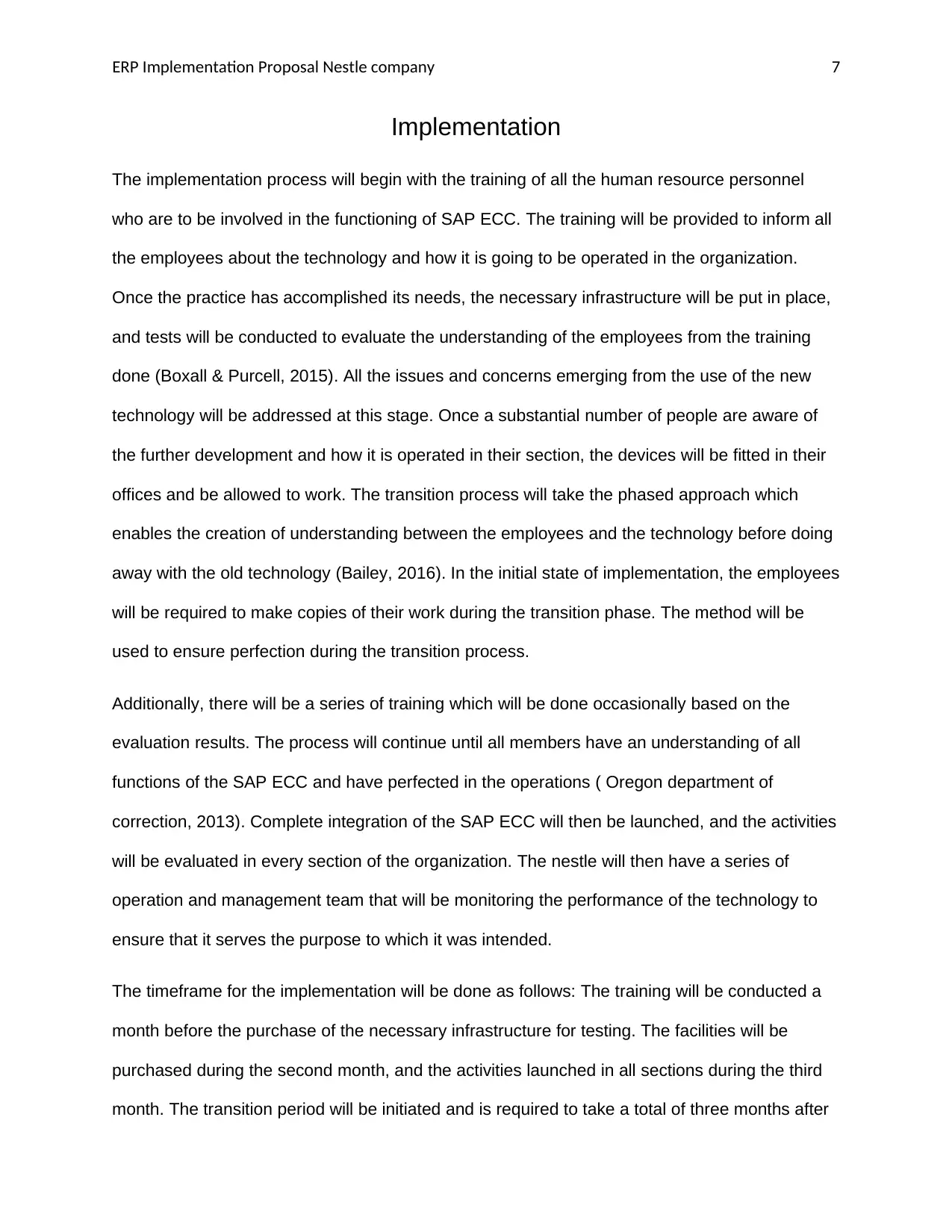
ERP Implementation Proposal Nestle company 7
Implementation
The implementation process will begin with the training of all the human resource personnel
who are to be involved in the functioning of SAP ECC. The training will be provided to inform all
the employees about the technology and how it is going to be operated in the organization.
Once the practice has accomplished its needs, the necessary infrastructure will be put in place,
and tests will be conducted to evaluate the understanding of the employees from the training
done (Boxall & Purcell, 2015). All the issues and concerns emerging from the use of the new
technology will be addressed at this stage. Once a substantial number of people are aware of
the further development and how it is operated in their section, the devices will be fitted in their
offices and be allowed to work. The transition process will take the phased approach which
enables the creation of understanding between the employees and the technology before doing
away with the old technology (Bailey, 2016). In the initial state of implementation, the employees
will be required to make copies of their work during the transition phase. The method will be
used to ensure perfection during the transition process.
Additionally, there will be a series of training which will be done occasionally based on the
evaluation results. The process will continue until all members have an understanding of all
functions of the SAP ECC and have perfected in the operations ( Oregon department of
correction, 2013). Complete integration of the SAP ECC will then be launched, and the activities
will be evaluated in every section of the organization. The nestle will then have a series of
operation and management team that will be monitoring the performance of the technology to
ensure that it serves the purpose to which it was intended.
The timeframe for the implementation will be done as follows: The training will be conducted a
month before the purchase of the necessary infrastructure for testing. The facilities will be
purchased during the second month, and the activities launched in all sections during the third
month. The transition period will be initiated and is required to take a total of three months after
Implementation
The implementation process will begin with the training of all the human resource personnel
who are to be involved in the functioning of SAP ECC. The training will be provided to inform all
the employees about the technology and how it is going to be operated in the organization.
Once the practice has accomplished its needs, the necessary infrastructure will be put in place,
and tests will be conducted to evaluate the understanding of the employees from the training
done (Boxall & Purcell, 2015). All the issues and concerns emerging from the use of the new
technology will be addressed at this stage. Once a substantial number of people are aware of
the further development and how it is operated in their section, the devices will be fitted in their
offices and be allowed to work. The transition process will take the phased approach which
enables the creation of understanding between the employees and the technology before doing
away with the old technology (Bailey, 2016). In the initial state of implementation, the employees
will be required to make copies of their work during the transition phase. The method will be
used to ensure perfection during the transition process.
Additionally, there will be a series of training which will be done occasionally based on the
evaluation results. The process will continue until all members have an understanding of all
functions of the SAP ECC and have perfected in the operations ( Oregon department of
correction, 2013). Complete integration of the SAP ECC will then be launched, and the activities
will be evaluated in every section of the organization. The nestle will then have a series of
operation and management team that will be monitoring the performance of the technology to
ensure that it serves the purpose to which it was intended.
The timeframe for the implementation will be done as follows: The training will be conducted a
month before the purchase of the necessary infrastructure for testing. The facilities will be
purchased during the second month, and the activities launched in all sections during the third
month. The transition period will be initiated and is required to take a total of three months after
Paraphrase This Document
Need a fresh take? Get an instant paraphrase of this document with our AI Paraphraser
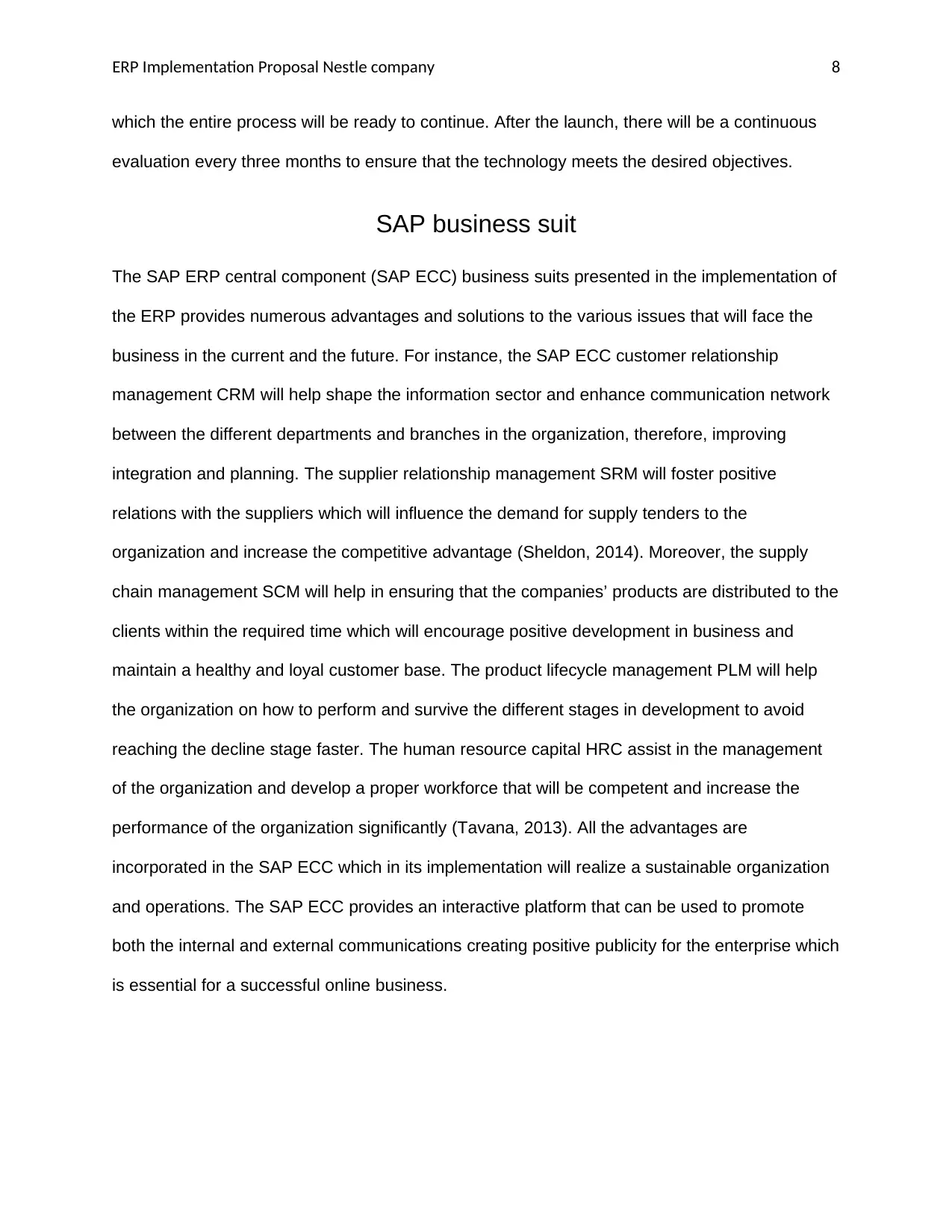
ERP Implementation Proposal Nestle company 8
which the entire process will be ready to continue. After the launch, there will be a continuous
evaluation every three months to ensure that the technology meets the desired objectives.
SAP business suit
The SAP ERP central component (SAP ECC) business suits presented in the implementation of
the ERP provides numerous advantages and solutions to the various issues that will face the
business in the current and the future. For instance, the SAP ECC customer relationship
management CRM will help shape the information sector and enhance communication network
between the different departments and branches in the organization, therefore, improving
integration and planning. The supplier relationship management SRM will foster positive
relations with the suppliers which will influence the demand for supply tenders to the
organization and increase the competitive advantage (Sheldon, 2014). Moreover, the supply
chain management SCM will help in ensuring that the companies’ products are distributed to the
clients within the required time which will encourage positive development in business and
maintain a healthy and loyal customer base. The product lifecycle management PLM will help
the organization on how to perform and survive the different stages in development to avoid
reaching the decline stage faster. The human resource capital HRC assist in the management
of the organization and develop a proper workforce that will be competent and increase the
performance of the organization significantly (Tavana, 2013). All the advantages are
incorporated in the SAP ECC which in its implementation will realize a sustainable organization
and operations. The SAP ECC provides an interactive platform that can be used to promote
both the internal and external communications creating positive publicity for the enterprise which
is essential for a successful online business.
which the entire process will be ready to continue. After the launch, there will be a continuous
evaluation every three months to ensure that the technology meets the desired objectives.
SAP business suit
The SAP ERP central component (SAP ECC) business suits presented in the implementation of
the ERP provides numerous advantages and solutions to the various issues that will face the
business in the current and the future. For instance, the SAP ECC customer relationship
management CRM will help shape the information sector and enhance communication network
between the different departments and branches in the organization, therefore, improving
integration and planning. The supplier relationship management SRM will foster positive
relations with the suppliers which will influence the demand for supply tenders to the
organization and increase the competitive advantage (Sheldon, 2014). Moreover, the supply
chain management SCM will help in ensuring that the companies’ products are distributed to the
clients within the required time which will encourage positive development in business and
maintain a healthy and loyal customer base. The product lifecycle management PLM will help
the organization on how to perform and survive the different stages in development to avoid
reaching the decline stage faster. The human resource capital HRC assist in the management
of the organization and develop a proper workforce that will be competent and increase the
performance of the organization significantly (Tavana, 2013). All the advantages are
incorporated in the SAP ECC which in its implementation will realize a sustainable organization
and operations. The SAP ECC provides an interactive platform that can be used to promote
both the internal and external communications creating positive publicity for the enterprise which
is essential for a successful online business.

ERP Implementation Proposal Nestle company 9
Training needs
There are however training needs that will have to be addressed in the organization. The first
training to be done will be during the introduction to the new technology which will be an
induction training informing the people about the technology and its advantages as well as the
problems they are to face (Rosario, 2016). The aim will be to reduce the resistance to change
which is common in organizations. Further training needs will be assessed through the
evaluation procedures and be addressed in the subsequent training that will be conducted after
every three months. Employees’ feedback will be collected on the new technology and be used
to inform further actions. Other issues to be put into consideration include the need for repair
and maintenance and follow-up to ensure information is updated each day on the system.
Advantages of adoption
The adoption of SAP ECC technology will help Nestle company to have a high competitive
advantage over their competitors in many ways. For instance, through SAP ECC quality control
for the organization will be enhanced since the organization will be brought to be under a joint
administration. The involvement of SAP ECC also will foster the organization's public image
(Stanford, 2016). The services will be coordinated properly, and all the employees will be
qualified and trained to meet the necessary criteria for inclusion making the organization to offer
uniformity in service delivery. The prices for products will be standardized as well as the method
of labeling the food being distributed which will make the brand to be outstanding regarding both
quality and presentation method. There will also be a clear understanding of the organization's
proceedings and errors emerging from any section of the organization will be detected faster,
therefore, encouraging faster action and prevent the information from going public. SAP ECC
will also enhance the purchasing department and make sure that the organization realizes the
places with the best offer for their inputs and therefore hire reputable suppliers who will deliver
Training needs
There are however training needs that will have to be addressed in the organization. The first
training to be done will be during the introduction to the new technology which will be an
induction training informing the people about the technology and its advantages as well as the
problems they are to face (Rosario, 2016). The aim will be to reduce the resistance to change
which is common in organizations. Further training needs will be assessed through the
evaluation procedures and be addressed in the subsequent training that will be conducted after
every three months. Employees’ feedback will be collected on the new technology and be used
to inform further actions. Other issues to be put into consideration include the need for repair
and maintenance and follow-up to ensure information is updated each day on the system.
Advantages of adoption
The adoption of SAP ECC technology will help Nestle company to have a high competitive
advantage over their competitors in many ways. For instance, through SAP ECC quality control
for the organization will be enhanced since the organization will be brought to be under a joint
administration. The involvement of SAP ECC also will foster the organization's public image
(Stanford, 2016). The services will be coordinated properly, and all the employees will be
qualified and trained to meet the necessary criteria for inclusion making the organization to offer
uniformity in service delivery. The prices for products will be standardized as well as the method
of labeling the food being distributed which will make the brand to be outstanding regarding both
quality and presentation method. There will also be a clear understanding of the organization's
proceedings and errors emerging from any section of the organization will be detected faster,
therefore, encouraging faster action and prevent the information from going public. SAP ECC
will also enhance the purchasing department and make sure that the organization realizes the
places with the best offer for their inputs and therefore hire reputable suppliers who will deliver
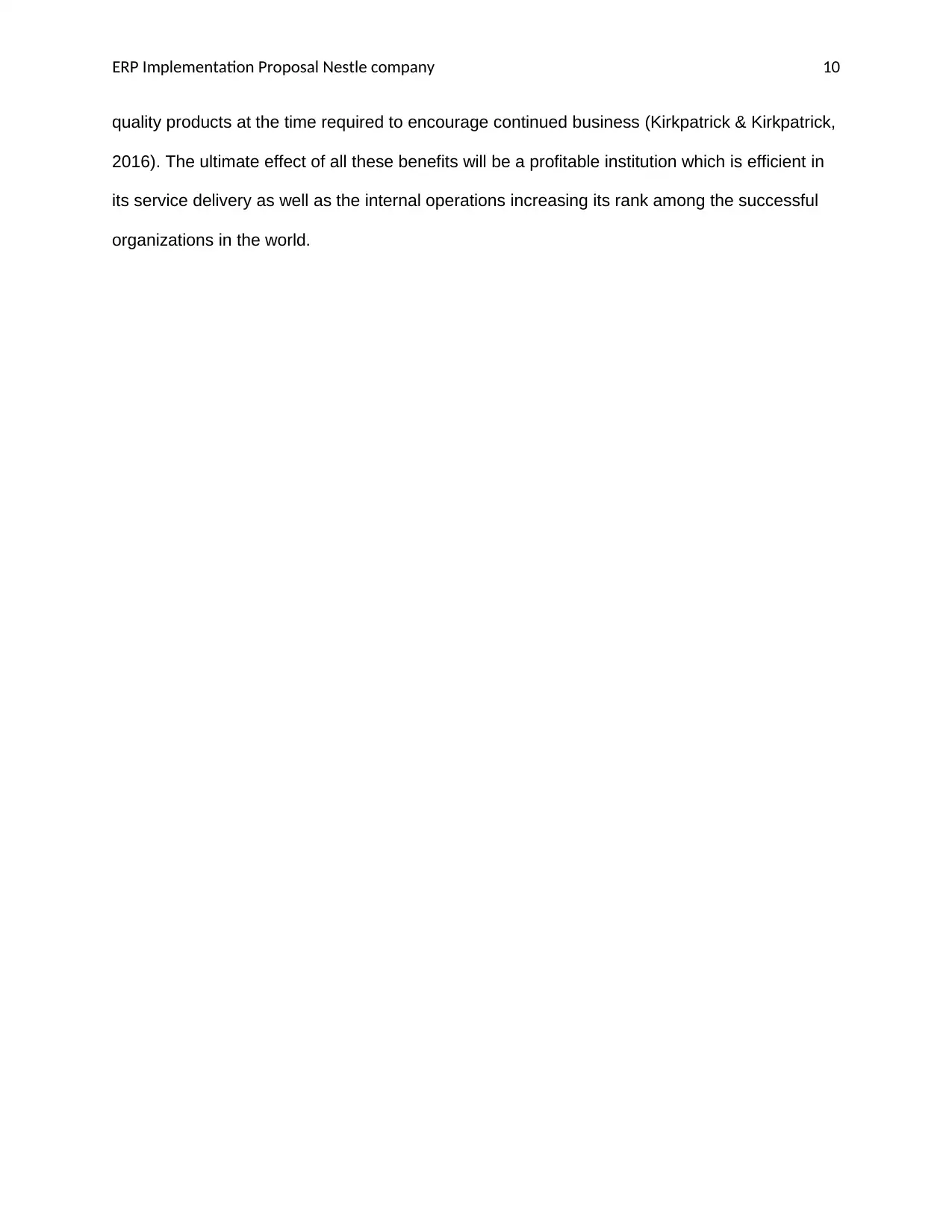
ERP Implementation Proposal Nestle company 10
quality products at the time required to encourage continued business (Kirkpatrick & Kirkpatrick,
2016). The ultimate effect of all these benefits will be a profitable institution which is efficient in
its service delivery as well as the internal operations increasing its rank among the successful
organizations in the world.
quality products at the time required to encourage continued business (Kirkpatrick & Kirkpatrick,
2016). The ultimate effect of all these benefits will be a profitable institution which is efficient in
its service delivery as well as the internal operations increasing its rank among the successful
organizations in the world.
Secure Best Marks with AI Grader
Need help grading? Try our AI Grader for instant feedback on your assignments.
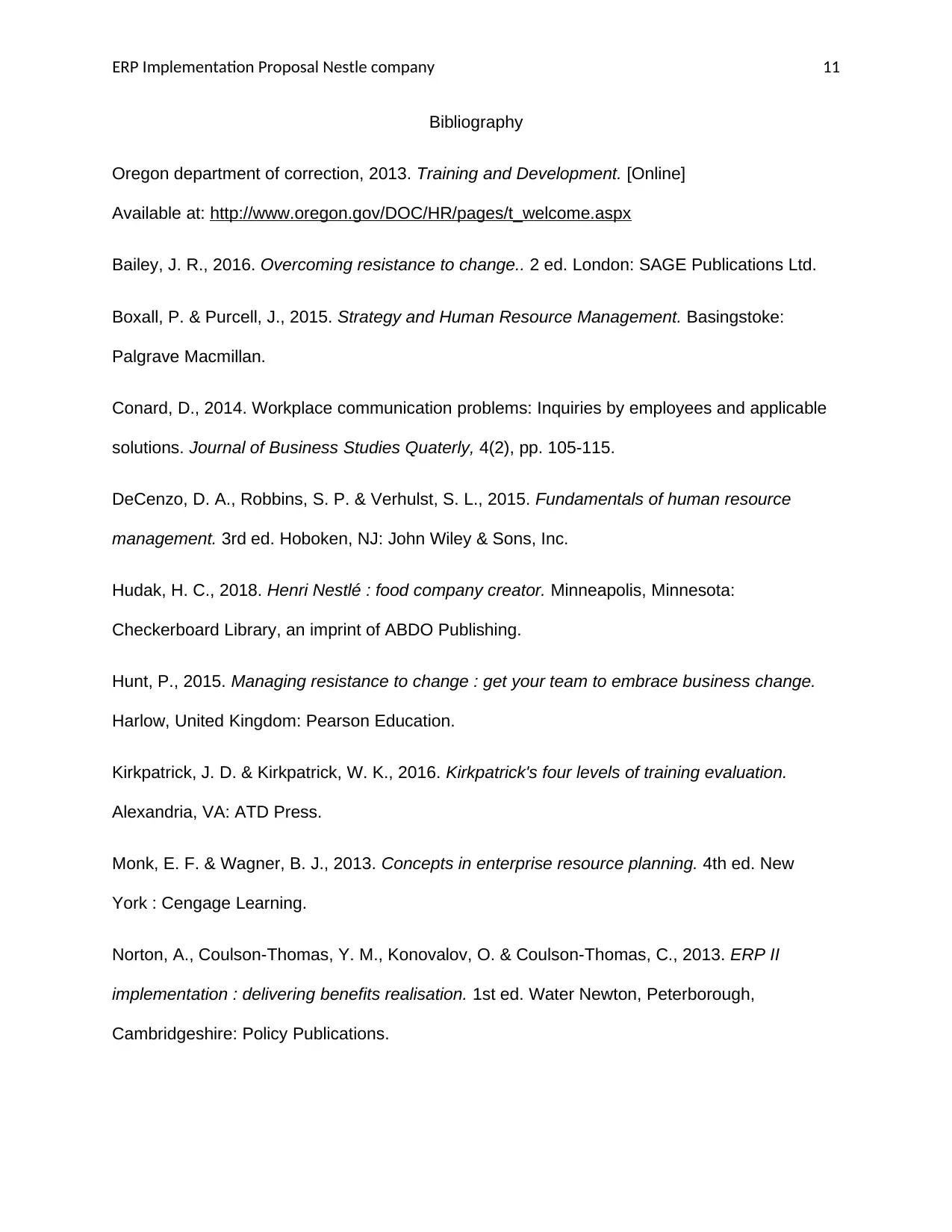
ERP Implementation Proposal Nestle company 11
Bibliography
Oregon department of correction, 2013. Training and Development. [Online]
Available at: http://www.oregon.gov/DOC/HR/pages/t_welcome.aspx
Bailey, J. R., 2016. Overcoming resistance to change.. 2 ed. London: SAGE Publications Ltd.
Boxall, P. & Purcell, J., 2015. Strategy and Human Resource Management. Basingstoke:
Palgrave Macmillan.
Conard, D., 2014. Workplace communication problems: Inquiries by employees and applicable
solutions. Journal of Business Studies Quaterly, 4(2), pp. 105-115.
DeCenzo, D. A., Robbins, S. P. & Verhulst, S. L., 2015. Fundamentals of human resource
management. 3rd ed. Hoboken, NJ: John Wiley & Sons, Inc.
Hudak, H. C., 2018. Henri Nestlé : food company creator. Minneapolis, Minnesota:
Checkerboard Library, an imprint of ABDO Publishing.
Hunt, P., 2015. Managing resistance to change : get your team to embrace business change.
Harlow, United Kingdom: Pearson Education.
Kirkpatrick, J. D. & Kirkpatrick, W. K., 2016. Kirkpatrick's four levels of training evaluation.
Alexandria, VA: ATD Press.
Monk, E. F. & Wagner, B. J., 2013. Concepts in enterprise resource planning. 4th ed. New
York : Cengage Learning.
Norton, A., Coulson-Thomas, Y. M., Konovalov, O. & Coulson-Thomas, C., 2013. ERP II
implementation : delivering benefits realisation. 1st ed. Water Newton, Peterborough,
Cambridgeshire: Policy Publications.
Bibliography
Oregon department of correction, 2013. Training and Development. [Online]
Available at: http://www.oregon.gov/DOC/HR/pages/t_welcome.aspx
Bailey, J. R., 2016. Overcoming resistance to change.. 2 ed. London: SAGE Publications Ltd.
Boxall, P. & Purcell, J., 2015. Strategy and Human Resource Management. Basingstoke:
Palgrave Macmillan.
Conard, D., 2014. Workplace communication problems: Inquiries by employees and applicable
solutions. Journal of Business Studies Quaterly, 4(2), pp. 105-115.
DeCenzo, D. A., Robbins, S. P. & Verhulst, S. L., 2015. Fundamentals of human resource
management. 3rd ed. Hoboken, NJ: John Wiley & Sons, Inc.
Hudak, H. C., 2018. Henri Nestlé : food company creator. Minneapolis, Minnesota:
Checkerboard Library, an imprint of ABDO Publishing.
Hunt, P., 2015. Managing resistance to change : get your team to embrace business change.
Harlow, United Kingdom: Pearson Education.
Kirkpatrick, J. D. & Kirkpatrick, W. K., 2016. Kirkpatrick's four levels of training evaluation.
Alexandria, VA: ATD Press.
Monk, E. F. & Wagner, B. J., 2013. Concepts in enterprise resource planning. 4th ed. New
York : Cengage Learning.
Norton, A., Coulson-Thomas, Y. M., Konovalov, O. & Coulson-Thomas, C., 2013. ERP II
implementation : delivering benefits realisation. 1st ed. Water Newton, Peterborough,
Cambridgeshire: Policy Publications.
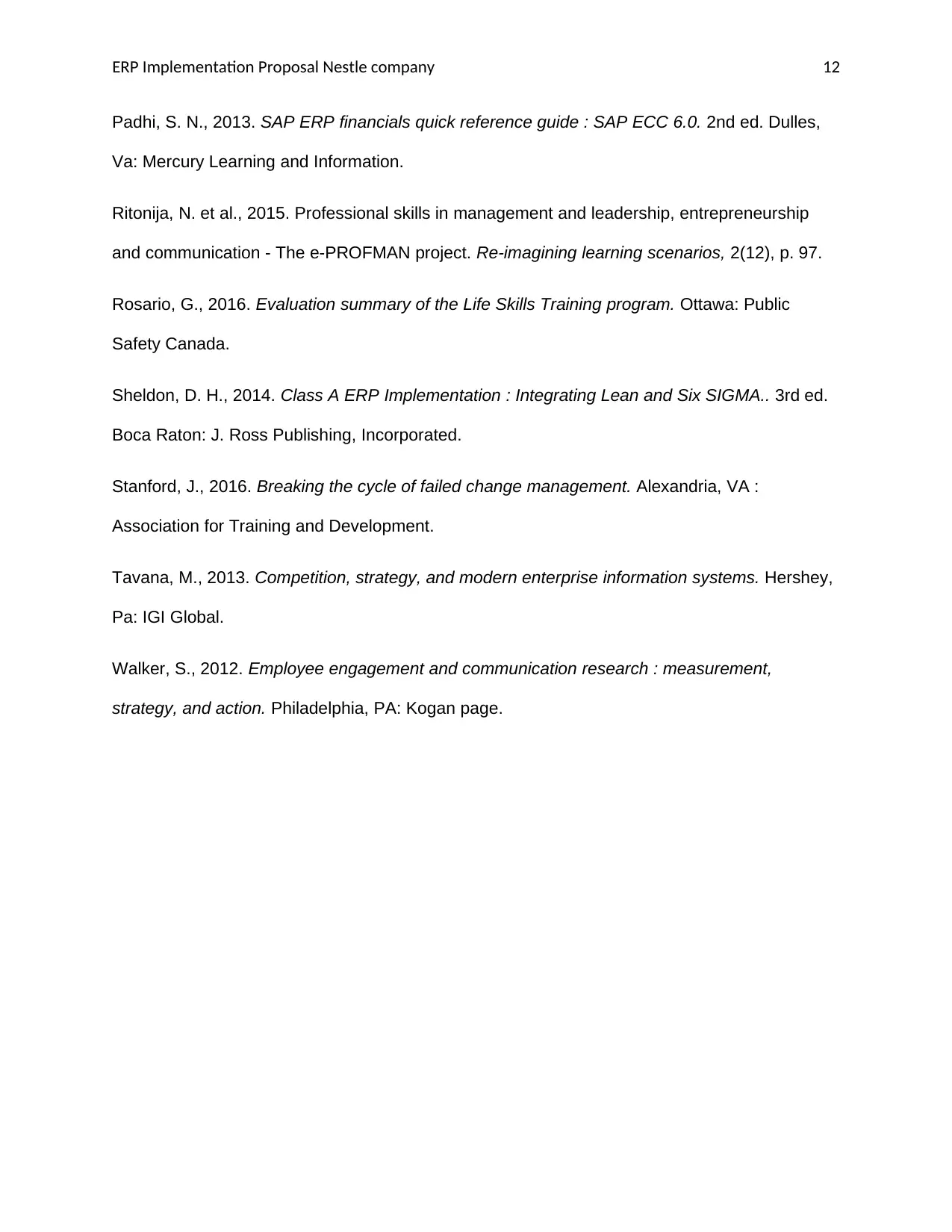
ERP Implementation Proposal Nestle company 12
Padhi, S. N., 2013. SAP ERP financials quick reference guide : SAP ECC 6.0. 2nd ed. Dulles,
Va: Mercury Learning and Information.
Ritonija, N. et al., 2015. Professional skills in management and leadership, entrepreneurship
and communication - The e-PROFMAN project. Re-imagining learning scenarios, 2(12), p. 97.
Rosario, G., 2016. Evaluation summary of the Life Skills Training program. Ottawa: Public
Safety Canada.
Sheldon, D. H., 2014. Class A ERP Implementation : Integrating Lean and Six SIGMA.. 3rd ed.
Boca Raton: J. Ross Publishing, Incorporated.
Stanford, J., 2016. Breaking the cycle of failed change management. Alexandria, VA :
Association for Training and Development.
Tavana, M., 2013. Competition, strategy, and modern enterprise information systems. Hershey,
Pa: IGI Global.
Walker, S., 2012. Employee engagement and communication research : measurement,
strategy, and action. Philadelphia, PA: Kogan page.
Padhi, S. N., 2013. SAP ERP financials quick reference guide : SAP ECC 6.0. 2nd ed. Dulles,
Va: Mercury Learning and Information.
Ritonija, N. et al., 2015. Professional skills in management and leadership, entrepreneurship
and communication - The e-PROFMAN project. Re-imagining learning scenarios, 2(12), p. 97.
Rosario, G., 2016. Evaluation summary of the Life Skills Training program. Ottawa: Public
Safety Canada.
Sheldon, D. H., 2014. Class A ERP Implementation : Integrating Lean and Six SIGMA.. 3rd ed.
Boca Raton: J. Ross Publishing, Incorporated.
Stanford, J., 2016. Breaking the cycle of failed change management. Alexandria, VA :
Association for Training and Development.
Tavana, M., 2013. Competition, strategy, and modern enterprise information systems. Hershey,
Pa: IGI Global.
Walker, S., 2012. Employee engagement and communication research : measurement,
strategy, and action. Philadelphia, PA: Kogan page.
1 out of 12
Related Documents
Your All-in-One AI-Powered Toolkit for Academic Success.
+13062052269
info@desklib.com
Available 24*7 on WhatsApp / Email
![[object Object]](/_next/static/media/star-bottom.7253800d.svg)
Unlock your academic potential
© 2024 | Zucol Services PVT LTD | All rights reserved.





